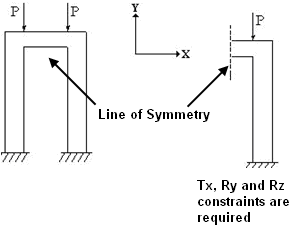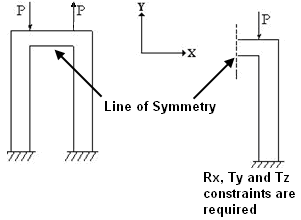Symmetry exists in a model when the geometry, loading and results are symmetric about a plane. If symmetry exists in a model, it is only necessary to model half of the model (or some other portion). When working with symmetric models, apply the correct boundary conditions along the plane of symmetry. Constrain the out-of-plane translation and the two in-plane rotations as shown in the following image. When applying boundary conditions, there are three buttons to automatically apply symmetry boundary conditions along the global planes. These buttons refer to the vector normal to the symmetry plane. For example, the X Symmetry button will apply symmetry boundary conditions along the YZ plane.

Antisymmetry exists in a model when the geometry is symmetric about a plane and the loading and results are antisymmetric about the same plane. If antisymmetry exists in a model, it is only necessary to model half of the model. When working with antisymmetric models, apply the correct boundary conditions along the plane of antisymmetry. Constrain the out-of-plane rotation and the two in-plane translations. The following image shows antisymmetry. When applying boundary conditions, there are three buttons to automatically apply antisymmetric boundary conditions along the global planes. These buttons refer to the vector normal to the antisymmetry plane. For example, the X Antisymmetric button will apply antisymmetric boundary conditions along the YZ plane.
